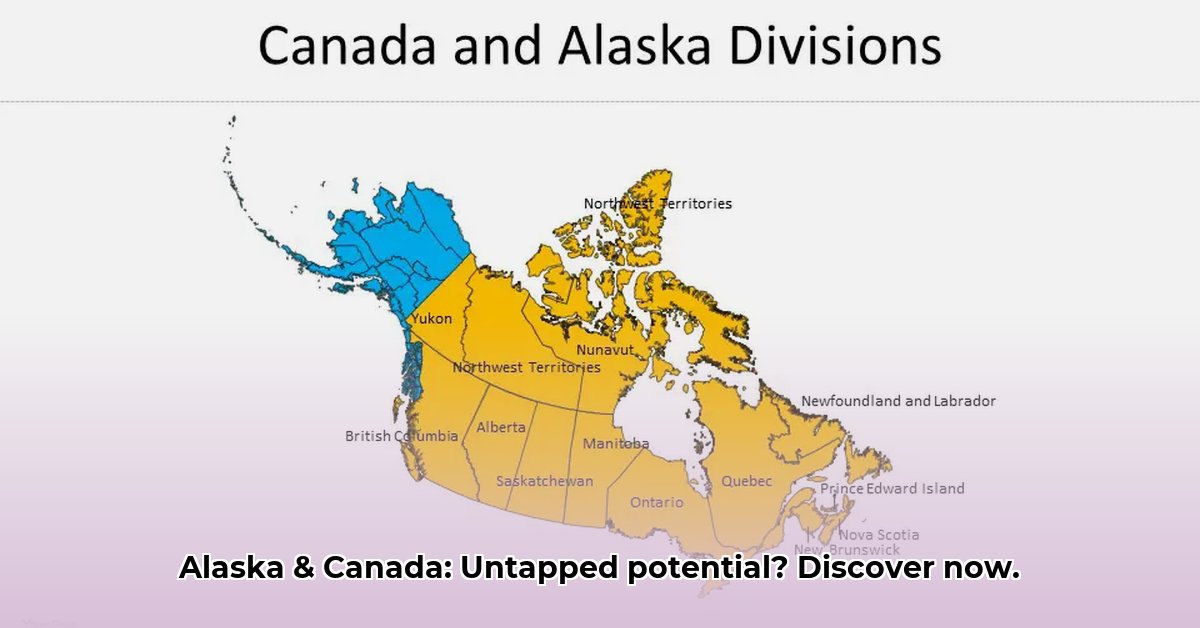Alaska and Canada, linked by a vast shared border and intertwined ecosystems, face a future of both immense opportunity and complex challenges. Their relationship, built on economic interdependence, environmental stewardship, and the recognition of Indigenous rights, is increasingly shaped by the changing geopolitical dynamics of the Arctic. This exploration delves into these interconnected facets, examining how collaboration and strategic foresight can pave the way for a sustainable and prosperous future for both regions. For a visual representation of the region, check out this map of western states.
Economic Crossroads: Balancing Resource Development and Environmental Protection
The economies of Alaska and Canada are intrinsically linked, with natural resource extraction playing a pivotal role in both. From the Trans-Alaska Pipeline System carrying crude oil to the bustling ports of Valdez and the prolific oil sands of Alberta, the energy sector fuels economic activity. Mining operations, particularly in British Columbia, Yukon, and Alaska, extract valuable minerals like gold, zinc, and coal. The timber industry, a significant economic driver, must navigate the delicate balance between economic needs and forest preservation. Thriving fishing industries, especially in Alaska and British Columbia, contribute significantly to the economic landscape, with salmon, crab, halibut, and pollock forming the backbone of this sector. The Alaska Highway, a vital artery connecting the two regions, facilitates trade and symbolizes their economic interconnectedness. However, this reliance on resource extraction presents a critical challenge: balancing economic growth with environmental sustainability.
The Pacific Salmon Treaty, a testament to successful cross-border collaboration, offers a model for joint resource management. This agreement addresses shared fishing rights and conservation efforts, ensuring the long-term health of salmon populations. Yet, disagreements persist over resource ownership, particularly concerning the Beaufort Sea maritime border and its potentially vast oil reserves. Innovative approaches are needed to resolve such disputes, ensuring equitable resource allocation while minimizing environmental impact. Investing in sustainable technologies and diversifying economies beyond resource extraction can create a more resilient economic future for both Alaska and Canada.
Environmental Stewardship: Confronting the Realities of a Changing Arctic
The Arctic, a fragile ecosystem shared by Alaska and Canada, is experiencing the dramatic effects of climate change at an accelerated pace. Melting permafrost threatens infrastructure and releases greenhouse gasses, while shrinking glaciers contribute to rising sea levels and disrupt delicate ecological balances. Coastal erosion jeopardizes communities and habitats, posing a significant threat to both human populations and wildlife. The iconic polar bear, caribou, and Arctic fox, symbols of this northern landscape, face habitat loss and dwindling food sources.
Transitioning to renewable energy sources is paramount. While Alaska explores wind and solar projects, Canada leverages its vast hydroelectric potential. However, this shift requires significant investment and infrastructure development. Furthermore, mitigating the impacts of climate change necessitates international collaboration. Data sharing, joint research initiatives, and coordinated climate action strategies are crucial for effectively addressing these shared environmental challenges. Protecting the biodiversity of the Arctic, a region of global ecological importance, requires a commitment to conservation efforts, habitat restoration, and sustainable resource management practices.
Indigenous Voices: Integrating Traditional Knowledge into Resource Management
Indigenous peoples, the original stewards of these lands, hold invaluable traditional ecological knowledge that is essential for sustainable resource management. The Alaska Native Claims Settlement Act (ANCSA) marked a significant step towards recognizing Indigenous land rights and promoting self-determination. In Canada, ongoing efforts focus on reconciliation, addressing historical injustices, and empowering Indigenous communities. However, true partnership requires more than legal frameworks; it demands meaningful participation in decision-making processes.
The Unuk River case exemplifies the complexities of transboundary resource management and Indigenous rights. Mining activities in British Columbia pose a direct threat to the Unuk River, a vital waterway for Southeast Alaska Indigenous tribes who rely on it for subsistence and cultural practices. The Canadian Supreme Court’s Desautel decision, affirming Indigenous rights across borders, has created a legal precedent with far-reaching implications. Integrating Indigenous perspectives into resource management decisions is not merely a matter of social justice; it is a practical imperative. Traditional ecological knowledge, accumulated over generations, offers valuable insights into sustainable practices and can inform effective conservation strategies.
Geopolitical Chessboard: Navigating Arctic Security in a Changing World
The Arctic’s increasing accessibility due to melting ice has elevated its geopolitical significance. New shipping routes and the potential for resource extraction have attracted global interest, creating both opportunities and challenges for Alaska and Canada. NORAD, the joint US-Canada aerospace defense command, demonstrates the long-standing security cooperation between the two nations. However, increased international activity in the Arctic necessitates a reevaluation of security strategies.
Balancing national interests with international cooperation is crucial. Enhanced diplomacy, transparent communication, and robust international agreements are essential for managing potential tensions and ensuring a stable Arctic future. Investing in climate-resilient infrastructure is vital for long-term sustainability in the face of a changing Arctic. Furthermore, proactive diplomacy and strategic foresight are essential for navigating the complex interplay of national interests and international cooperation in this strategically important region. By fostering collaboration and addressing shared challenges, Alaska and Canada can unlock the vast potential of their shared frontier while safeguarding its unique environment and respecting the rights of its Indigenous peoples.
















